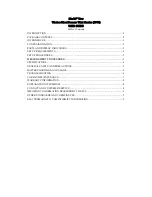
4
Interfaces
All connectors on the S360A face down, making cables easy to
run into the monitor and enabling mounting close to a wall.
Connect the MAINS INPUT to the mains supply. Any mains
voltage globally can be accepted (100-240 VAC, 50-60 Hz) so
the monitor can be plugged in anywhere. When the mains power
is provided with a generator, inverter or certain lower-quality UPS
devices, we recommend filtering of the mains voltage to reduce
harmonics and taking care that the voltage supply is stable.
Type RJ-45 connectors for the CONTROL NETWORK are
used with Genelec Loudspeaker Manager (GLM) management
network. These connectors are not Ethernet LAN compatible.
Do not connect to Ethernet LAN.
The ANALOG IN connector accepts balanced analog audio
signals. The maximum analogue input level is +25 dBu. The
default input sensitivity is set so that for a -6 dBu input level the
S360A produces 100 dB SPL sound level at one meter in free
space. The analogue input impedance is 10 kOhm, so line level
audio sources can drive it.
The DIGITAL IN AES/EBU female XLR connector is for AES/
EBU formatted digital audio input signals. This input is selected
automatically when a digital audio signal is present, even when
the digital audio is silent. The analog input is reselected when
the AES/EBU signal input is disconnected. The AES/EBU input
supports two channels in a single cable. When the digital source
controls the level, it may be advantageous to lower the level setting
in the monitor’s controls, which will enable a higher digital level
and improved use of the digital resolution. The digital input level is
referenced to 0 dBFS (dB relative to the digital full scale, the largest
level that can be represented in the AES/EBU signal). The S360A
sensitivity is scaled to produce 100 dB SPL sound level at one
meter in free space for a digital input signal of –30 dBFS.
The DIGITAL OUT male XLR carries an unaltered copy of the
digital input signal. This enables daisy-chaining with digital signal
up to four monitors.
Figure 5. Symmetrical layout and keeping the acoustic
axis clear from obstructions minimizes reflection surfaces
and maintains accurate localisation because reflections are
symmetrical.
Table 1. Suggested Tone Control settings for some typical moni-
tor placement positions.
Monitor
Mounting Position
Treble
Tilt
Bass
Tilt
Bass
Roll-Off
Desktop
Flat anechoic
response
None
None
None
None
Free standing in
a damped room
None
-2 dB
None
None
Free standing in
a reverberant room
None
-4 dB
None
None
Near field on
a reflective surface
None
-2 dB
None
-4 dB
In a corner
None
-4 dB
-4 dB
None
Measurement data
Calibration data
Unique microphone calibration
selected by microphone serial number
Genelec
consultation
Genelec Cloud
Settings
Test signal
GLM AutoCal
Figure 4. The GLM Cloud enables the room response compensation.






























